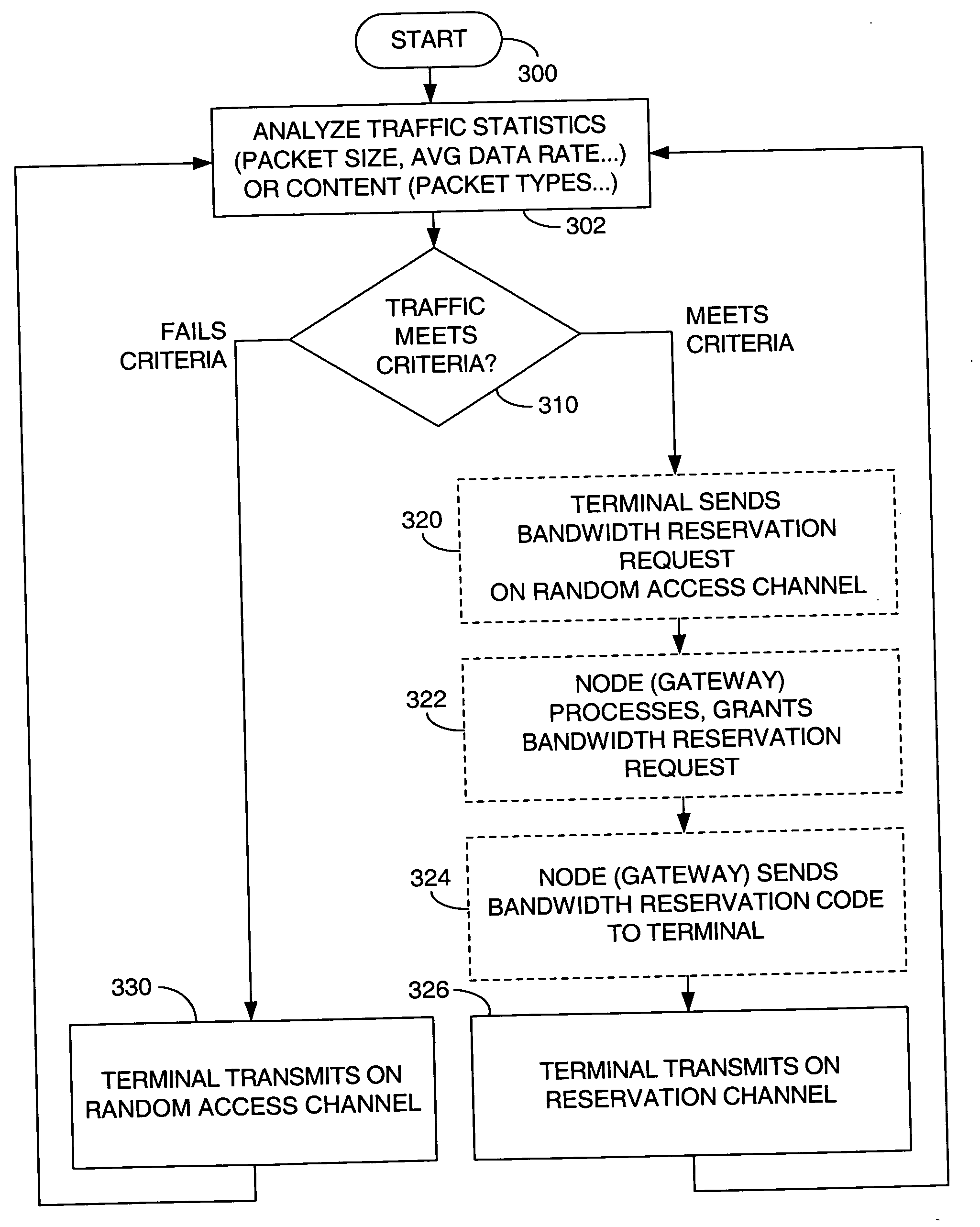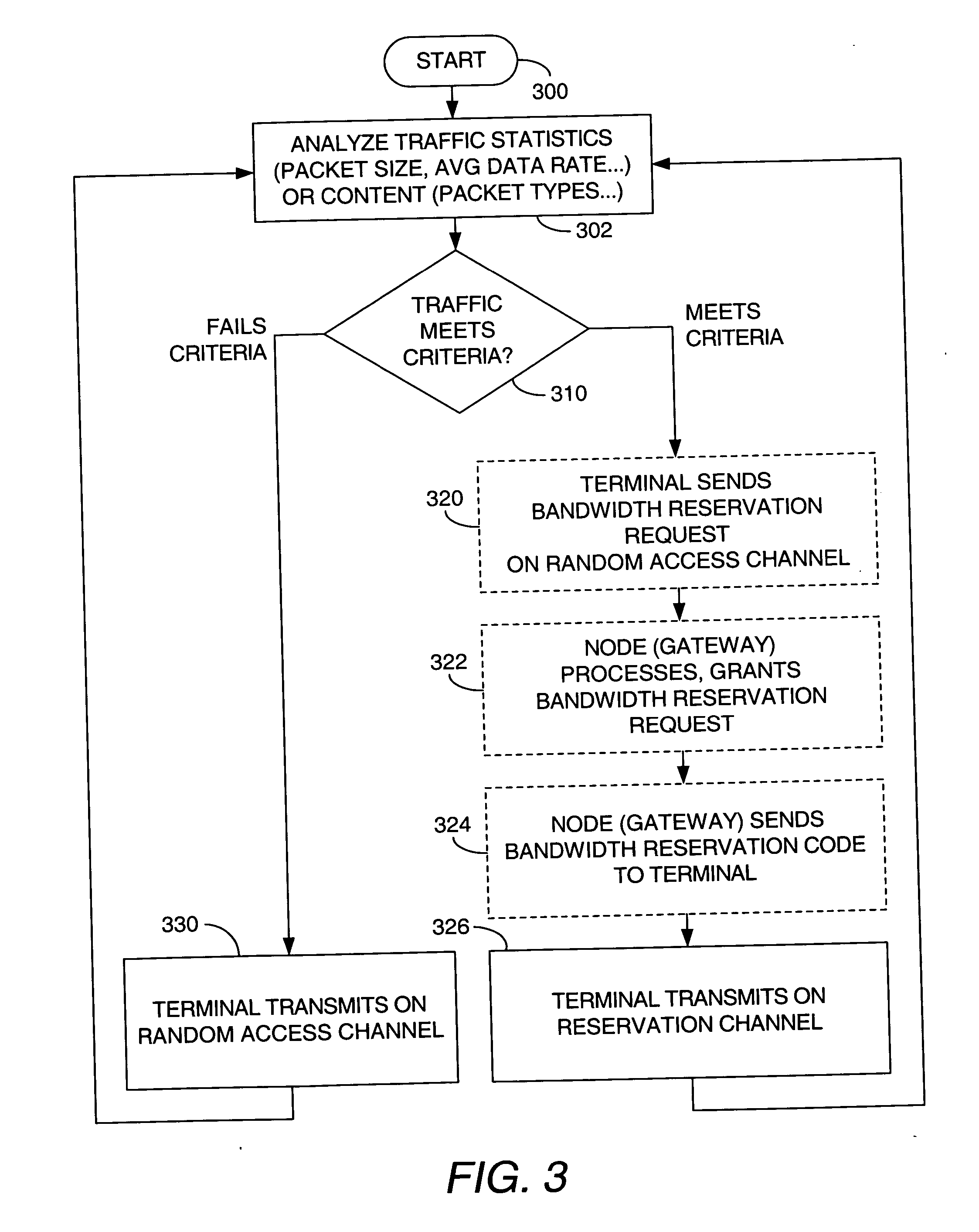Managing traffic in communications system having dissimilar CDMA channels
a communication system and channel technology, applied in the field of managing traffic in data communication systems, can solve the problems of tdma systems, lower bandwidth efficiency, and longer access delay
- Summary
- Abstract
- Description
- Claims
- Application Information
AI Technical Summary
Benefits of technology
Problems solved by technology
Method used
Image
Examples
first embodiment
[0045] First embodiment (refer to FIG. 2). In a first embodiment, all traffic is carried on the RACH. An advantage of transmitting on the RACH is that the packets can be sent as soon as they are generated, and there is no additional reservation request delay.
[0046] Referring to FIG. 2, a flow chart illustrates steps of an exemplary implementation of the first embodiment. Block 200 represents the start of the process, followed by block 210 that indicates transmission of data on the random access channel. Block 220 represents the end of the process, when data transmission is completed.
[0047] Disadvantages of transmitting exclusively on the RACH include low bandwidth efficiency and low data rate.
second embodiment (refer to fig.3)
[0048] Second embodiment (refer to FIG. 3). A second approach for managing return link traffic is described with reference to HTTP traffic. Of course, it is recognized that embodiments need not be limited to HTTP traffic embodiments; other types of services may also be handled similarly.
[0049] In this second approach, the characteristics of traffic from a given terminal (CPE) are analyzed. The traffic characteristics that are analyzed, may include traffic statistics such as packet size or average data rate measured over a time period) or traffic content (such as packet type). Based on the analyzed traffic characteristics, traffic is thereafter transmitted on either the random access channel (RACH) or on a reservation-oriented channel (RESCH).
[0050] In one example, the terminal sends smaller packets (such as TCP acknowledgements) on the RACH. However, when a terminal desires to send a packet of length larger than a certain threshold size, the terminal requests bandwidth on the RESCH...
second embodiment
[0051] Referring to FIG. 3, a flow chart illustrates steps of an exemplary implementation of the second embodiment, with block 300 indicating the start of the process.
[0052] Block 302 illustrates the analysis of data traffic relating to a given terminal. For example, traffic statistic(s) such as packet size or average data rate over a given time period are analyzed. Alternatively, the traffic content such as packet type or other criteria is analyzed. In one embodiment, the raw analysis takes place at the terminal but in other embodiments this analysis takes place in the node.
[0053] Block 310 illustrates a decision based on the analysis of traffic statistics or traffic content from block 302. If the analyzed traffic statistic falls below a threshold, or if traffic content fails a given criterion or criteria, then control passes to block 330 which indicates that the terminal transmits on the RACH. However, if the analyzed traffic meets or exceeds the threshold, or if traffic content ...
PUM
 Login to View More
Login to View More Abstract
Description
Claims
Application Information
 Login to View More
Login to View More - R&D
- Intellectual Property
- Life Sciences
- Materials
- Tech Scout
- Unparalleled Data Quality
- Higher Quality Content
- 60% Fewer Hallucinations
Browse by: Latest US Patents, China's latest patents, Technical Efficacy Thesaurus, Application Domain, Technology Topic, Popular Technical Reports.
© 2025 PatSnap. All rights reserved.Legal|Privacy policy|Modern Slavery Act Transparency Statement|Sitemap|About US| Contact US: help@patsnap.com



